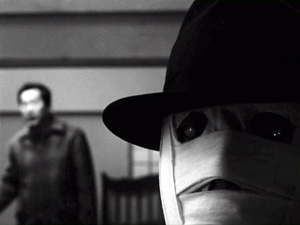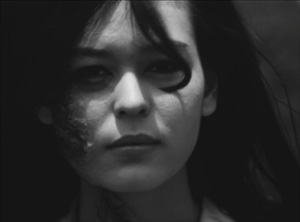The idea that your entire identity can be lost upon a horrible disfigurement to your face is nothing new to the world of cinema. Films such as Georges Franju’s Eyes Without a Face and Jess Franco’s The Awful Dr. Orloff have explored  these themes before with varying degrees of success. These same themes in the hands of auteur Hiroshi Teshigahara and surrealist Kôbô Abe however produce a beast altogether different than anything seen before. The Face of Another is a film far ahead of its time, and a masterpiece of lost identity.
these themes before with varying degrees of success. These same themes in the hands of auteur Hiroshi Teshigahara and surrealist Kôbô Abe however produce a beast altogether different than anything seen before. The Face of Another is a film far ahead of its time, and a masterpiece of lost identity.
Mr. Okuyama, a high ranking chemist, is horribly disfigured in a laboratory explosion. He’s forced to go through life wearing bandages that cover his entire face, and because of this he’s fallen into a deep depression, most notably due to his wife shunning him in the bedroom. He turns to a psychiatrist, who also seems to be proficient in plastic surgery, to create a new face for him, one he would use to live a double life. The psychiatrist initially refuses, claiming that this would be unethical, but soon caves in, seeing it as an interesting experiment. With the mask a success, Okuyama is given a second chance at life, although it may force him to confront things about himself that he would have rather ignored.
The Face of Another is truly an anomaly when it comes to this style of film, choosing to focus more on the character with the affliction and how he struggles with it than on the actual situation he’s in. Okuyama is quite depressed, and rightfully so, but as the film unfolds, you begin to question his sanity, but not in ways you would have originally expected to. Of course you expect someone that’s been horribly disfigured to suffer mental instability, but would you expect to begin second guessing whether the way you see him is actually the way he is? In other words, this disfigurement that has caused him so much anguish may very will be internal, not physical. You’ll find yourself questioning whether the psychiatrist is truly a character in Okuyama’s world, or just another “face” of his own persona that is helping him cope with his internal strife. Teshigahara and Abe have certainly crafted a film about a crisis of identity that is on par with David Lynch’s Mulholland Drive or Lost Highway, and have astonishingly done it some 30+ years before.
A unique technique used by Teshigahara is inter-splicing an alternative story within the main stories narrative. Early in the film, Okuyama speaks with his wife about a film he had just seen at the theatre about a girl that, like him, has a facial disfigurement. With that, we are treated throughout the film with snippets from this story/film that parallels Okuyama’s own plight. The young woman in this storyline chooses to leave her scarred face out in the open, learning to live with her shortcoming as best she can. She is however more than inclined to cover the scar up with her hair if the situation calls for it; and as happy of a face as she puts on, she’s not as content with her problem as she portrays.  At first, we’re led to believe that her story and Okuyama’s are meant to be taken in contrast, but as the stories move along, we see that they are maybe much more alike than we initially thought. While the transitions from one story to the other can at times be jarring, overall it works very well in the confines of such a film that isn’t content with being conventional.
At first, we’re led to believe that her story and Okuyama’s are meant to be taken in contrast, but as the stories move along, we see that they are maybe much more alike than we initially thought. While the transitions from one story to the other can at times be jarring, overall it works very well in the confines of such a film that isn’t content with being conventional.
Tatsuya Nakadai is probably my favorite actor of all time, and here he does not disappoint in the least. In fact, it’s the nuances in his performance that actually led me to believe that this film is dealing more with an internal turmoil than something that’s on the surface. He comes off as two completely different people when he wears the mask versus the bandages, and there are a few other odd personalities he takes on during the film as well. While it’s not a selling point of the film, Nakadai seems to play multiple characters in this film, and in my eyes it rivals the astounding performance of Jeremy Irons in David Cronenberg’s Dead Ringers. Also worth noting is the score of experimental composer Tôru Takemitsu, which becomes just as much of a character in the film as the actors themselves.
As I stated in the opening paragraph, Teshigahara can certainly be considered as an auteur, and because of that you would expect some striking visuals. I’m happy to say that you’ll indeed get just that. There’s some wonderful techniques used here, from the opening shot of the x-rayed skull of Nakadai explaining his plight, to bizarre visual cues that at first seem completely out of place, yet 10 minutes later prove to be foreshadowing of something that was to come. In one particular scene, a door opens on large strands of hair, seemingly floating in space. At the time, it  comes off as odd and completely out of place. Just a few minutes later however, the purpose of it is revealed. The film also has a few dashes of commentary on WWII paranoia, told through the alternate storyline. Again, this could certainly parallel Okuyama’s internal turmoil; is the tragedy of WWII the cause of his personal crisis?
comes off as odd and completely out of place. Just a few minutes later however, the purpose of it is revealed. The film also has a few dashes of commentary on WWII paranoia, told through the alternate storyline. Again, this could certainly parallel Okuyama’s internal turmoil; is the tragedy of WWII the cause of his personal crisis?
The ending sequence is truly something that any film fan should experience, and is a revealing affair that provides many answers through its surrealistic flourishes. Teshigahara proves in this film that you can be as surrealistic as you want to be, as long as you dangle that string in front of the viewer that will allow them, if they’re paying attention, to pull back the curtain on what film is trying to convey. None of the imagery here is indulgent or merely for show; it all plays a part if you’re willing to look. If you argue that Teshigahara is being surrealistic just for the sake of being “artsy”, you’d be wrong.
The Face of Another is a film that is ripe for discussion and debate. Whether you want to experience it for its amazing cinematic eye, its surrealistic descent into the mind of a man conflicted about his own identity, its tinges of horror and sci-fi themes, or its incredible score and performances, it is a film that certainly deserves to be experienced. The questions it asks are profound ones, and you may find yourself trying to figure out what makes you “you” after seeing it. Just try not to lose sight of your true self in the process.
Please feel free to discuss "The Face of Another" here, in our forums!

